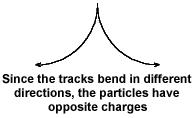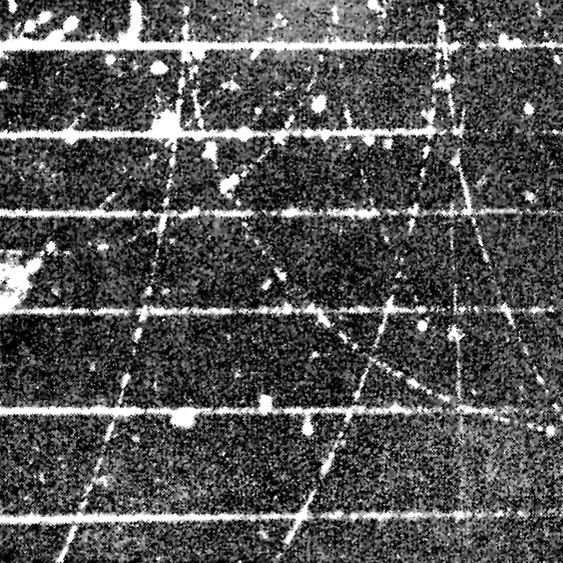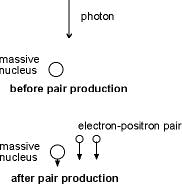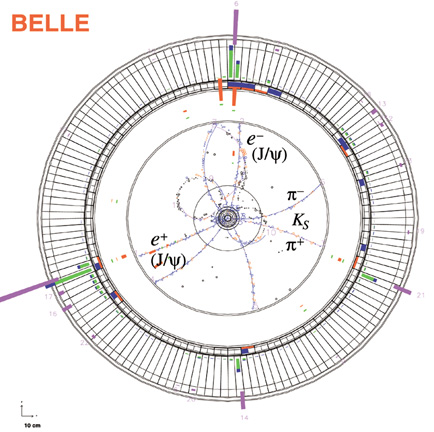The Buzz about Antimatter
This photograph shows particle tracks in a cloud chamber. As charged particles pass through the supersaturated vapor in this chamber, they leave behind a visible trail of tiny droplets.
Notice the pairs of curved trails that meet at the top of the image to form a curved, upside-down "v" shape. The curvature results from a magnetic field at right angles to the plane of the photograph, which bends the paths of charged particles into circular arcs. The opposite curvature of the lines that make each "v" shows that the charges of the two particles are opposite.
| particle | mass | charge | |
| MATTER | electron | me | -e |
| proton | mp | +e | |
| ANTIMATTER | positron | me | +e |
| antiproton | mp | -e |
The positrons created in this experiment are one kind of antimatter. Each particle of ordinary matter, such as the electron and the proton, has an antimatter counterpart, with the same mass but opposite charge, as shown in the table. A high-energy photon that passes near a massive nucleus can decay into a particle-antiparticle pair. The cloud chamber photograph shows an example of how the energy of radiation changes into the energy of mass.
Imagine the opposite process—bringing an electron and a positron together. The result can be the annihilation of both particles and the creation of two gamma ray photons. In this case, the energy of mass changes into the energy of radiation.


Particle tracks in a cloud chamber
More about the Cloud Chamber
Conservation of momentum:
Relativistic mechanics shows that the conservation of momentum in gamma ray annihilation requires the presence of a massive nucleus nearby to carry off some of the photon's momentum. Since its mass is very large, this nucleus acquires only a small velocity in this process.
Conservation of energy:
 The rest mass energy of the electron and of the positron is .511 MeV (million electron volts). Consequently, the photon must have an energy of at least 1.022 MeV to create this pair. Any additional photon energy goes into the kinetic energy of the electron and positron. Since the massive nucleus nearby acquires only a small velocity compared to the electron and positron, it carries off very little kinetic energy (which is proportional to the square of the speed).
The rest mass energy of the electron and of the positron is .511 MeV (million electron volts). Consequently, the photon must have an energy of at least 1.022 MeV to create this pair. Any additional photon energy goes into the kinetic energy of the electron and positron. Since the massive nucleus nearby acquires only a small velocity compared to the electron and positron, it carries off very little kinetic energy (which is proportional to the square of the speed).
Since the presence of the nearby nucleus is required for the photon annihilation, and since space is an excellent vacuum, gamma rays travel through space with an essentially infinite lifetime. Also, since the minimum photon energy for this annihilation is about 1 MeV, forms of electromagnetic energy with smaller photon energies do not annihilate when passing through matter. Imagine the effect on the history of life if light photons annihilated while passing through the waters of the oceans!
Research
The prevailing theories about the early universe predict the creation of equal amounts of matter and antimatter in the big bang. However, if this were the case, then the universe, as we know it, would not exist. Matter and antimatter are arch rivals. When they meet, they annihilate each other, usually into bursts of light. So if matter and antimatter were really created in equal amounts, then the universe should contain only light— not the stars, planets, and other matter we see today. The very fact that we exist means that the universe is lopsided with a slight preference for matter—so slight that the ratio of light to ordinary matter is a billion to one. But what caused this imbalance?
The answer is that we don't know for sure! But we have an idea. One of the most important pieces of this theory has been around for nearly four decades but we haven't had the machinery to test it further—until now. Currently, teams of physicists in California and Japan are using powerful particle accelerators to observe direct evidence of "nature's preference" for matter, which physicists call "CP Violation."
The idea is simple—produce lots of extremely short- lived particles called B mesons and their antiparticles. Then, watch for differences in how they decay.
For decades, we've been able to see that the B meson's little brother, the K-meson or kaon, has different decay products than its antimatter counterpart. However, kaon decays are too simple to provide much insight into the origins of the matter/antimatter imbalance that occurred after the big bang. This is where the bulky B and anti-B mesons come in—their decays are far more complex and, hence, interesting to physicists. And soon, we could have part of the answer to the eternal question: why are we here? At least physically…

B meson decay candidate at the BELLE detector in Japan. (Image courtesy of BELLE collaboration)
Links
Live from CERN
NASA's Space Science News
Encyclopedia Britannica
- Still more about antimatter
- Pair production more about pair production and annihilation
- Cloud chamber more about the cloud chamber

A burst of light is emitted as the electron and its antiparticle, the positron, collide. (Image credit: NASA - Goddard Space Flight Center Visualization Studio)














